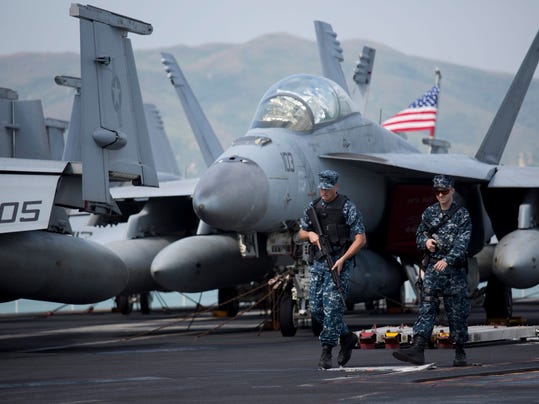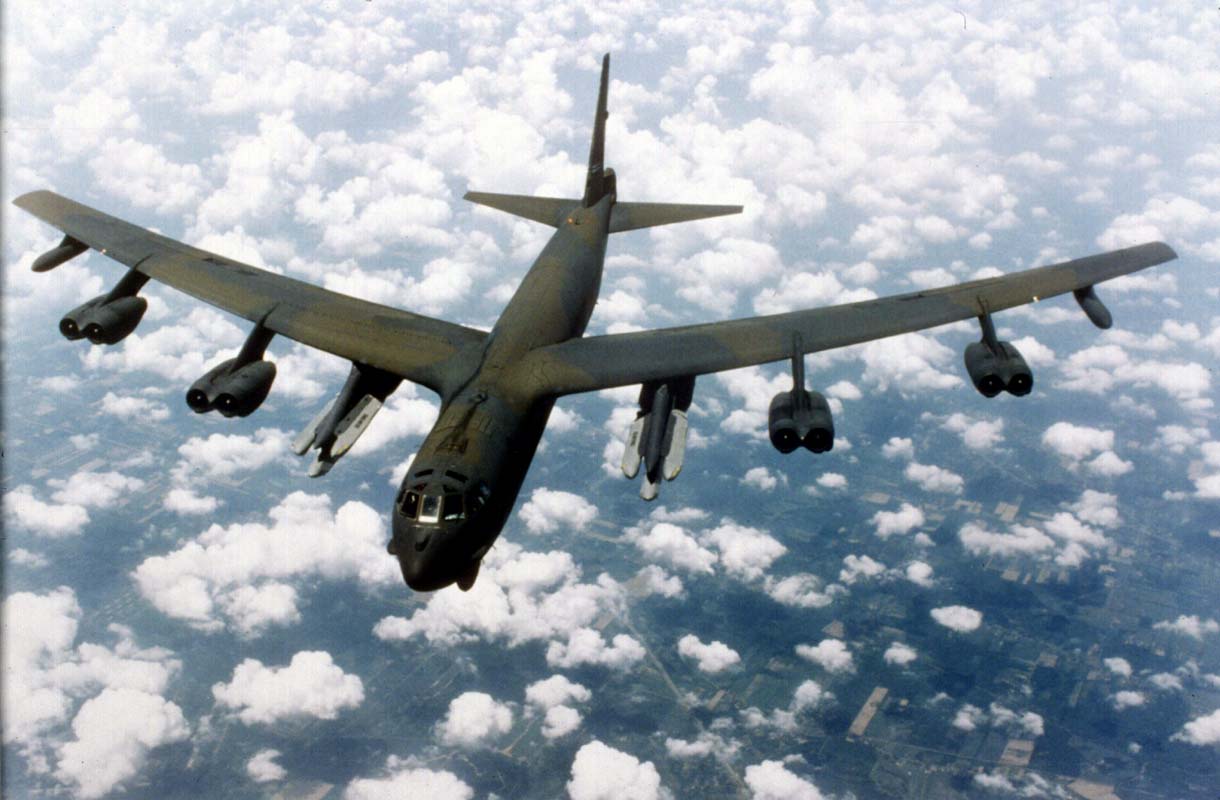By Kirk Spitzer
- China claiming nearly 1 million square miles of East China Sea
- Japan Prime Minister Shinzo Abe confronts China
- U.S. treaty obligates Pentagon to defend Japan

NAHA, OKINAWA, Japan — An American carrier battle group and a flotilla of Japanese warships will arrive Wednesday near a vast stretch of ocean claimed by China in what is shaping up as a test of how Prime Minister Shinzo Abe and the USA will stand up to the challenge.
The joint U.S.-Japan exercises in the sea are a direct challenge to China's claim.
On Tuesday, the U.S. military said two Air Force B-52 bombers flew over the sea without notifying Beijing despite China's demand that it be told if anyone plans to fly military aircraft over its self-claimed "air defense zone.
The aircraft took off from Guam on Monday, part of a regular exercise, said a U.S. defense official who spoke to AFP news service on condition of anonymity because he was not authorized to divilge the information.
China has been laying claim to nearly 1 million square miles of ocean known as the East China Sea, insisting that the sea's energy resources and fisheries belong to China.
The aircraft took off from Guam on Monday, part of a regular exercise, said a U.S. defense official who spoke to AFP news service on condition of anonymity because he was not authorized to divilge the information.
China has been laying claim to nearly 1 million square miles of ocean known as the East China Sea, insisting that the sea's energy resources and fisheries belong to China.
Much of the ocean territory it claims is hundreds of miles from its shore, including waters off the coasts of Japan, Taiwan and South Korea.
On Saturday China went further than ever, announcing it had designated much of the sea as an air-defense zone it controls.
On Saturday China went further than ever, announcing it had designated much of the sea as an air-defense zone it controls.
The zone includes the Japanese Senkaku Islands, a string of uninhabited islets.
The Chinese Defense Ministry said the zone was created to "guard against potential air threats."
"China has been pushing and testing Abe since he took office and for the most part he has been passing," said Brad Glosserman, executive director of the Pacific Forum Center for Strategic and International Studies, a think tank in Honolulu.
"This is a very dumb, very risky move by China," he said.
"China has been pushing and testing Abe since he took office and for the most part he has been passing," said Brad Glosserman, executive director of the Pacific Forum Center for Strategic and International Studies, a think tank in Honolulu.
"This is a very dumb, very risky move by China," he said.
"If the People's Liberation Army tries to interfere (with the US-Japan exercise), there will be real problems."
The challenge represents a test for Abe, a conservative party prime minister elected in 2012 who has vowed to shift Japan's deferential military posture to a more muscular stance that recognizes its right to defend itself.
On Tuesday, Abe directly confronted China, stating he would not recognize the Chinese air zone over the East China Sea or any of its claims to the Senkakus.
"We will take steps against any attempt to change the status quo by use of force as we are determined to defend the country's sea and airspace," Abe said.
For the U.S.' part, Defense Secretary Chuck Hagel said the Chinese action represents a "destabilizing attempt to alter the status quo" and "will not in any way change how the United States conducts military operations in the region."
To that end, the U.S. Navy arrived in force Tuesday off the coast of Japan for a complex exercise in which Japanese naval ships and U.S. fighter jets, warships and submarines will practice scenarios for a possible attack on Japan.
Sailing into the waters southeast of Okinawa on Tuesday to prepare for a long-planned exercise was the aircraft carrier USS George Washington, guided-missile cruiser USS Antietam, guided-missile destroyers USS Curtis Wilbur, USS Lassen, USS McCampbell, USS Mustin, maritime patrol and reconnaissance aircraft and a Navy submarine.
China issued a protest with Japan and the U.S. government over the exercises and opposition to China's self-claimed right to an air-defense zone over the sea.
The challenge represents a test for Abe, a conservative party prime minister elected in 2012 who has vowed to shift Japan's deferential military posture to a more muscular stance that recognizes its right to defend itself.
On Tuesday, Abe directly confronted China, stating he would not recognize the Chinese air zone over the East China Sea or any of its claims to the Senkakus.
"We will take steps against any attempt to change the status quo by use of force as we are determined to defend the country's sea and airspace," Abe said.
For the U.S.' part, Defense Secretary Chuck Hagel said the Chinese action represents a "destabilizing attempt to alter the status quo" and "will not in any way change how the United States conducts military operations in the region."
To that end, the U.S. Navy arrived in force Tuesday off the coast of Japan for a complex exercise in which Japanese naval ships and U.S. fighter jets, warships and submarines will practice scenarios for a possible attack on Japan.
Sailing into the waters southeast of Okinawa on Tuesday to prepare for a long-planned exercise was the aircraft carrier USS George Washington, guided-missile cruiser USS Antietam, guided-missile destroyers USS Curtis Wilbur, USS Lassen, USS McCampbell, USS Mustin, maritime patrol and reconnaissance aircraft and a Navy submarine.
China issued a protest with Japan and the U.S. government over the exercises and opposition to China's self-claimed right to an air-defense zone over the sea.
Defense Ministry spokesman Yang Yujun said Japan's complaint about the zone is "absolutely groundless and unacceptable," according to Japan's Kyodo news service.
Yang said Japan has "no right to make irresponsible remarks" on the sea's airspace, portions of which have been jointly administered by Japan and the United States for decades.
Yang said Japan has "no right to make irresponsible remarks" on the sea's airspace, portions of which have been jointly administered by Japan and the United States for decades.
Yujun also urged the United States to "not take sides."
Earlier this year, Japan scrambled fighter jets when Chinese planes flew near the Senkaku islands, a rich fishing ground annexed by Japan in 1895 and purchased by the legislature in 2012.
Earlier this year, Japan scrambled fighter jets when Chinese planes flew near the Senkaku islands, a rich fishing ground annexed by Japan in 1895 and purchased by the legislature in 2012.
Chinese interceptor aircraft conducted the first flights into the zone after it went into force at 10 a.m. on Saturday.
The Chinese moves have inflamed Japan and worried other nations that say they may now need to inform China when their commercial flights are heading over the East China Sea.
The Chinese moves have inflamed Japan and worried other nations that say they may now need to inform China when their commercial flights are heading over the East China Sea.
It also has U.S. allies concerned that China is becoming more aggressive against them since the installation a year ago of Xi Jinping as leader of the Communist regime.
But Hagel reaffirmed the U.S. military commitment to the 1952 U.S.-Japan Mutual Defense Treaty that commits Washington to intervene in defense of Japan if there is an attack on Japanese-administered territory. And Abe has backed up his belief that Japan must modify its stance held since World War II that Japan's defense can be outsourced entirely to the United States.
Abe has been pressing for Japan to raise its readiness and play a bigger role in global security since he came to power in December 2012 and won a majority for his Liberal Democratic Party in the upper house of the Japan legislature in July.
Defense spending in Japan has seen its largest increase in 22 years, says Kyodo.
But Hagel reaffirmed the U.S. military commitment to the 1952 U.S.-Japan Mutual Defense Treaty that commits Washington to intervene in defense of Japan if there is an attack on Japanese-administered territory. And Abe has backed up his belief that Japan must modify its stance held since World War II that Japan's defense can be outsourced entirely to the United States.
Abe has been pressing for Japan to raise its readiness and play a bigger role in global security since he came to power in December 2012 and won a majority for his Liberal Democratic Party in the upper house of the Japan legislature in July.
Defense spending in Japan has seen its largest increase in 22 years, says Kyodo.
The spending has zeroed in on boosting Japan's capabilities to defend against amphibious assaults.
But Abe has yet to garner the votes to change Japan's constitution so its defense forces can project the full military powers of a sovereign state.
But Abe has yet to garner the votes to change Japan's constitution so its defense forces can project the full military powers of a sovereign state.
The constitution, written by the U.S. military after the defeat of Japan in WWII, restrains what Japan can do militarily.
The U.S. military retains bases in Japan, primarily in Okinawa, and exercises between the two militaries have grown in size and complexity in recent years.
Although precise locations have not been announced for the latest exercise, specific training events — which will include land-based patrol planes and other aircraft — are supposed to take place across large stretches of Japanese and international airspace, including parts of the East China Sea.
China's Ministry of National Defense announced that any foreign aircraft entering its newly drafted "East China Sea Air Defense Identification Zone" must file a flight plan with Chinese authorities, stay in two-way radio contact and follow other instructions.
Failure to do so will result in "defensive emergency measures" by China's armed forces, according to the statement.
It is not clear why China chose to announce the new air restrictions now, said Narushige Michishita, Director of the Security and International Studies Program at the National Graduate Institute for Policy Studies in Tokyo.
The U.S. military retains bases in Japan, primarily in Okinawa, and exercises between the two militaries have grown in size and complexity in recent years.
Although precise locations have not been announced for the latest exercise, specific training events — which will include land-based patrol planes and other aircraft — are supposed to take place across large stretches of Japanese and international airspace, including parts of the East China Sea.
China's Ministry of National Defense announced that any foreign aircraft entering its newly drafted "East China Sea Air Defense Identification Zone" must file a flight plan with Chinese authorities, stay in two-way radio contact and follow other instructions.
Failure to do so will result in "defensive emergency measures" by China's armed forces, according to the statement.
It is not clear why China chose to announce the new air restrictions now, said Narushige Michishita, Director of the Security and International Studies Program at the National Graduate Institute for Policy Studies in Tokyo.
Whether Xi Jinping approved of it or the military demanded it is unknown, Michishita said.
"It is a scary scenario," Michishita said.
"It is a scary scenario," Michishita said.
"What happens next is up to China."








0 comments:
Post a Comment